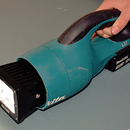Introduction: Smokeless Fire Pit From Junk
If you wanted a fire pit that doesn't chase you with the smoke this is the project for you. This project was way easy to build and worked so much better than I imagined, the smoke is greatly reduced and you won't get burning eyes and have a coughing fit if you get caught downwind. If you have ever sat around a campfire you know what I'm talking about. I use the fire pit in a covered area and there is no issue with smoke in the face or lungs, and as a bonus, I no longer smell like a forest fire after sitting near the fire pit. I can say this is well worth the effort to build.
The fire in the GIF was burning leaf litter and sticks in attempt to make it smoke but the fire pit burnt very clean.
Supplies
The fire pit was made from an old clothes dryer and a Propane tank, the most expensive part was the three bolts that hold the legs on. You will also need a few tools that you most likely already have access to if you are reading this. You will also need material to make three legs
Jigsaw, grinder, welder, drill and some drill bits, tape, tape measure marker pen are about all the tools you will need.
Step 1: How a Smokeless Fire Pit Works
The fire pit uses a secondary combustion system, and smokeless fire pits draw the air from the bottom of the pit. The air gets super hot, rises, works its way up the side walls, and is then sent back through vent holes around the lip of the fire pit. Jets of fire are created, which inevitably burn the smoke before it can leave the pit. Although you’ll find a bit of smoke when the fire begins, it’s then practically smokeless for the rest of the burn.
Step 2: Harvesting the Junk You Need
I was lucky? enough to have an old clothes dryer, funny story it was replaced because a rat found its way inside and made itself at home which was all good, until my misses threw some clothes in there and turned it on. Let's just say it didn't end well for everyone involved, least of all the rat who is now homeless.
The dryer comes apart pretty easily just pull off the back and the heating element and the stainless steel drum will pull out. The propane tank was one I've had for a while it has a leaky valve so I'm not going to use it again. The photo shows the dryer drum on top of the tank I was checking out the sizes of everything it looked very close
Step 3: You Have Been Warned
Cutting into a propane tank should not be taken lightly, if you are thinking of using a torch or grinder this is not the project for you.... The other thing that is not so obvious is that propane has some sort of chemical added to it to make it smell, so you know there is a gas leak. This seems to embed into the tank and when you start cutting into it the smell is.... well let's say something like a cross between an oil refinery and a meth lab.
Do it outside far away from the house and neighbours, the stink gets into everything, you will have to burn your clothes and shave your head afterwards.
Still here? the safe way is to fill the tank with water and cut it with a jigsaw. it cut very easily apart from the smell...I use a paper template to mark out the line as you can see in the photos it just makes it easy to get the line straight and square.
Step 4: Marking and Cutting the Drum
Fighting off the stink, I just place the propane tank over the opening of the dryer drum and traced a line around it I probably should have put a mark to index the drum and on the tank as the tank was surprisingly not perfectly round. The drum was then cut with a cut-off wheel on an angle grinder. I then ground the powder coating off the top to prepare it for welding.
The propane tank was a near-perfect fit, there is a welded seam at the bottom of the tanks that had to have about a mm ground off in three places where the three ribs in the dryer drum sit. It was that close, like it was made to be a fire pit!
Step 5: Marking Out and Drilling the Holes
This is the most tedious part of the project, I measure the perimeter of the tank and laid out some painter's tape the same length and marked out the spacing about 50mm apart. Im sure there is some science involved in calculating the amount and size of the holes, but I never looked it up it seems to work just fine.
I centre-punched all the holes and drilled them out with a step drill. the top holes are about 10mm and the bottom about 13mm.
I put a hole in the bottom so the rain can drain out.
About this time I got sick of the unholy stink, so set fire to the tank in an attempt to send it back to the depths of hell from whence it came, I burnt my clothes and, bathed in a creek with the locals with pitch forks and torches throwing garlic and wooden stakes at me screaming Witch! Witch!
Step 6: Legs
After escaping the angry mob, I started on the legs. the pit need to be lifted up off the ground as that I how the air gets in I used some rivnuts, in the end of the legs and ended up having to weld them in as I could not get them to crush without the proper tool I put some button head bolts on the top and just enlarge three holes in the bottom of the drum so the legs can slip in and can be removed for transport.
Step 7: Welding in the Tank
The fire did the trick and was able to send the stench to the fires of Mordor, and now I can get back to welding the tanked and drum together. the galvanising was ground off the tank and the drum had the powder coating sanded off the top of the drum.
I had a hard time welding this part I think I probably did not get all the galv off and also there was powder coating on the inside of the drum that I did not notice until it was welded up and it was too late, the weld is very ugly and I hang my head in shame at making such a rookie mistake.
That said well worth the effort and the fire pit works a treat!
One downside is that the stainless steel does not radiate heat to my legs very well, I think because of the colour of the steel. I like the look of the shiny steel but may end up painting it matt black with heat prof pot belly or automotive exhaust paint.

First Prize in the
Metal Contest













